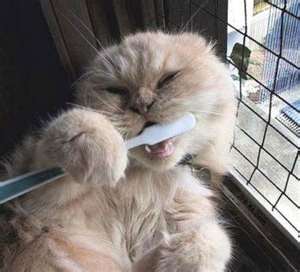It is important for you to check your pet’s mouth on a routine basis and we also check the mouth when you bring your pet in for an annual exam. If left unchecked, bacteria from the mouth can enter the bloodstream and travel to the lungs, heart, kidneys, liver & even the brain, starting infections there and seriously compromising the health of your pet. Almost all dental disease can be prevented with proper management. We recommend brushing your pet’s teeth as often as you can, daily is best or, if brushing is not possible, try using an oral rinse or chews.
Dental disease can be put into three categories: gingivitis, tartar and pyorrhea. Gingivitis is inflammation of the gums. You can easily see this by the increase in pinkness of your pet’s gums, especially at the gum line. Tartar is the accumulation of plaque on the teeth, usually starting at the gum line in conjunction with gingivitis. Pyorrhea is the most serious of the three conditions. It is pus in the mouth, usually between teeth and gums. All three of these conditions require treatment which can range from antibiotics to a full dental cleaning. Animals who are in need of a dental procedure or cleaning will be put under general anesthesia to have it performed. So if you notice an odor coming from your pet’s mouth, plaque build up or discoloration, please call us and schedule an appointment, a dental might be needed.
What does a dental cleaning involve?
Pet dental cleanings involve some tools that you are already familiar with. We use a high speed ultrasonic scaler to remove tartar from the teeth as well as under the gum line. This is just like the tool your own dental hygienist uses. We follow up with a high speed polisher to smooth out the dental surfaces. During the procedure, we check under the gum line for pockets and infection. We evaluate the health of every individual tooth, to insure that we don’t leave behind a source of infection, or a painful tooth. We make sure that every surface of the tooth is cleaned, including the inside and outside surfaces, as well as under the gum line.
Safety Precautions
Unlike our dental visits, our pets’ require to be under full anesthesia in order to do the most thorough and beneficial cleaning. We are very careful to monitor your pet during the entire procedure. A veterinary technician monitors your pet’s vital signs, including heart rate, respiration, and blood pressure. Measurements are taken at timed intervals and recorded. Adjustments to your pet’s anesthesia are made in accordance to their response and vital signs. We place the patient on the lowest level of anesthesia necessary. Prior to the procedure we will often evaluate bloodwork to insure that major organs such as liver and kidneys are healthy. Anesthesia is cleared by these organs, and it is vital to know that they are in a healthy state prior to the dental procedure. We have many test options and our veterinarians will personally evaluate your pet’s individual needs.

